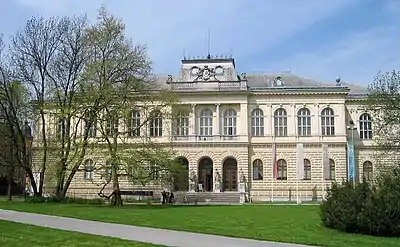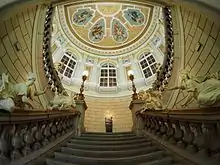National Museum of Slovenia
The National Museum of Slovenia (Slovene: Narodni muzej Slovenije) is located in Ljubljana, the capital of Slovenia. It is situated in the Center district of the city near Tivoli City Park. Along with the Slovenian Museum of Natural History, located in the same building, the National Museum of Slovenia is the country's oldest scientific and cultural institution. The museum has an extensive collection of archaeological artefacts, old coins and banknotes (in the numismatics department on the ground floor) and displays related to the applied arts.

History
The museum was founded in 1821 as the "Estate Museum of Carniola" (German: Krainisch Ständisches Museum). Five years later, the Austrian Emperor Francis I decided to personally sponsor the museum and ordered its renaming to "Provincial Museum of Carniola". In 1882, the museum was renamed to "Provincial Museum of Carniola - Rudolfinum" in honour of the Crown Prince Rudolph.

After the establishment of the Kingdom of Serbs, Croats and Slovenes, the name was changed to "National Museum". In 1923 the ethnographic collections possessed by the museum were removed and placed in the new Slovene Ethnographic Museum and in 1933 much of its fine artwork was moved to the National Gallery of Slovenia. In 1944 the Slovenian Museum of Natural History (then known as the Museum of Natural Sciences) became independent despite being located in the same building. In 1953 the majority of archives were moved to the Gruber Palace.
Renamed to National Museum of Slovenia in 1992, today the museum is divided into Archaeological Department, a Numismatic Cabinet, a Department of Prints and Drawings and a Department of History and the Applied Arts.
The building
_(2).jpg.webp)
The main building of the National Museum is located close to the Slovenian Parliament building and the Slovenian Foreign Ministry, while the Ljubljana Opera House stands just opposite to it on the same square. It was built in the Neo-Renaissance style by the master builder Wilhelm Treo in collaboration with Jan Vladimír Hráský between 1883 and 1885. Treo mostly followed the plans by the Viennese architect Wilhelm Rezori.
The interior was designed by Hráský, with the ceiling of the main hall decorated with medaillons by the painters Janez and Jurij Šubic.[1] These were created in 1885. Janez Šubic drew the main allegorical painting of Carniola as the protector of arts and sciences, whereas Jurij Šubic drew four portraits of famous Carniolans: Johann Weikhard von Valvasor, Valentin Vodnik, Sigmund Herberstein and Sigmund Zois. The painting by Janez was made with oil on wood, whereas the portraits were made with oil on fresh plaster. The painters followed the proposals of their teacher Janez Wolf. The space between the medaillons was decorated by Karel Lipovšek.[2]
The building was solemnly opened on 2 December 1888.[1] In the Slovene Lands, this was the first building used solely for cultural purposes.[3] A bronze monument to the Carniolan polymath Johann Weikhard von Valvasor, designed by the sculptor Alojz Gangl, was placed in front of the museum in 1903.[4]
Selected directors and collaborators
- Karel Dežman (1821–1889)
- Josip Mal (1884–1978)
- Avgust Pirjevec (1887–1944)
- Simon Rutar (1851–1903)
- Boris M. Gombač (born 1945)
References
- "Kjer že 120 let domuje zgodovina Slovencev" [Where Already 120 Years Resides the History of the Slovenes] (in Slovenian). MMC RTV Slovenija. December 2008.
- "Odprti kop: Pogled na ...: Poslikave v Narodnem muzeju" [Open Dig: A View of...: The Paintings in the National Museum] (in Slovenian). October 2009. Archived from the original on 30 July 2013. Retrieved 30 July 2013.
- Paulič, Anja. "Archivalia of the Month (July 2013): Wilhelm Rezori: Draft of the Future Building of the Carniolan Provincial Museum (Frontage, Ground Floor, First Floor)". Archives of the Republic of Slovenia, Ministry of Culture, Republic of Slovenia. Retrieved 29 July 2013.
- Rozman, Ksenija (1965). "Ljubljanski javni spomeniki". Kronika: časopis za slovensko krajevno zgodovino (in Slovenian). Zveza zgodovinskih društev Slovenije, sekcija za krajevno zgodovino. 13 (2): 197.
External links
| Wikimedia Commons has media related to National Museum of Slovenia. |